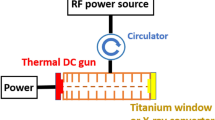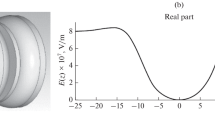Abstract
Purpose
As the development of smaller accelerators technique, an X-band bi-period side-coupled accelerating structure has been designed for medical use.
Methods
The structure’s working frequency is 9.3 GHz. \(\pi /2\) mode is chosen for the structure’s stability. There are 11 accelerating cells and 10 coupling cells, the first 5 of the accelerating cells work as non-light velocity part (\(\beta \) of the electron from 0.17 to 0.94), while the other 6 work as light velocity part. After CST simulation, the coupling constant between accelerating cells and coupling cells is 5%, and efficient shunt impedance is 142 \(M\Omega /m\). To feed power into the structure, a coupler is designed in the middle of the structure and the coupling coefficient is 1.4.
Results
After optimization, the particle’s capture efficiency is more than 30%, the particle energy is 2 MeV and the peak current is 60 mA, with the magnetron’s input power being 0.32 MW.
Conclusion
X-band side-coupled accelerator efficiency is high and is a more optimized design. This design is very meaningful for the development of smaller accelerators technique.









Similar content being viewed by others
References
H. Qiao-Mu, in Encyclopedia of New China (Encyclopedia of China Publishing House, Beijing, 1993), pp. 164–165
C.S. Nunan, Present and future applications of industrial accelerators, in Proceedings of the 9th Fermilab Industrial Affiliates Roundtable on Applications of Accelerators, pp. 55–88 (1989)
J.E. Clayton, Status of the accelerator industry in North America, in Proceedings of IPAC’10, pp. 2461–2465 (2010)
M. Schillo, Global industrial development of accelerators for charged particle therapy, in Proceedings of IPAC2014, pp. 1912–1916 (2014)
A. Saverskiy, H. Deruyter, M. Hernandez, Portable X-band linear electron accelerators for radiographic applications, in Proceedings of 2005 Particle Accelerator Conference, pp. 1985–1987 (2005)
M. Uesaka, K. Demachi, K. Dobashi et al, Applications of X-band 950 KeV and 3.95 MeV linac x-ray source for onsite inspection, in Proceedings of IPAC2012, pp. 4071–4073 (2012)
R. Uršič, Present status and future outlook of the accelerator industry in Europe, in Proceedings of IPAC2010, pp. 2456–2460 (2010)
S. Xiang, T. Dechun, J. Qingxiu, A portable x-band on-axis standing wave linac structure, in Proceedings of the PAC97, pp. 1221–1223 (1997)
P. Tomas, R.F. Wangler, Linear Accelerators, (WILEY-VCH, 2008), pp. 110
Y. Chong-Guo, Electron Linear Accelerator, (Science Press, Beijing, 1986), pp. 660–671
B. Spataro, D. Alesini, A. Bacci et al., A bi-periodic X-band cavity for SPARC. Nucl. Instrum. Methods Phys. Res. 586, 133–142 (2008)
S. Ahmadiannamin, F. Abbasidavani, R. Ghaderi et al, Design and simulation of side coupled 6 Mev linac for X-ray cargo inspection, in Proceedings of IPAC2014, pp. 3844–3846 (2014)
G. Burt, P.K. Ambattu, C. Lingwood, Design and operation of a compact 1 MeV X-band linac, in Proceedings of LINAC2012, pp. 183–185 (2012)
S. Boucher, R. Agustsson, L. Faillace, et al, Compact, inexpensive X-band linacs as radioactive isotope source replacements, in Proceedings of IPAC2013, pp. 3746–3748 (2013)
J. St Aubin, S. Steciw, B.G. Fallone, The design of a simulated in-line side-coupled 6 MV linear accelerator waveguide. Med. Phys. 37, 466–476 (2010)
Author information
Authors and Affiliations
Corresponding author
Additional information
Supported by National Natural Science Foundation of China (11275222).
Rights and permissions
About this article
Cite this article
Hao-Wei, Y., Mi, H. & Bin, G. Design and optimization of a 2 MeV X-band side-coupled accelerating structure. Radiat Detect Technol Methods 1, 10 (2017). https://doi.org/10.1007/s41605-017-0010-6
Received:
Revised:
Accepted:
Published:
DOI: https://doi.org/10.1007/s41605-017-0010-6




